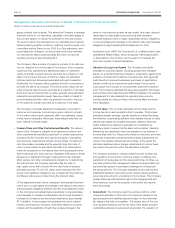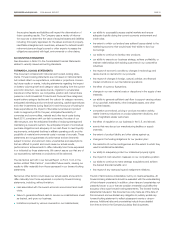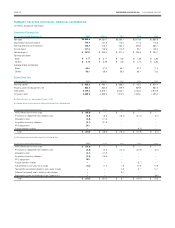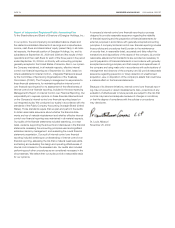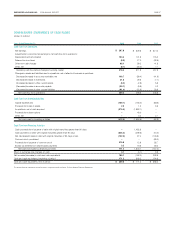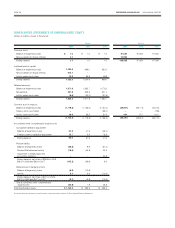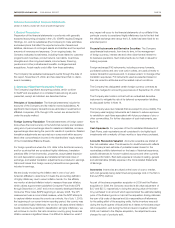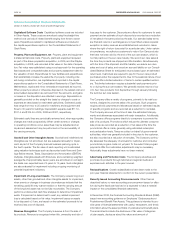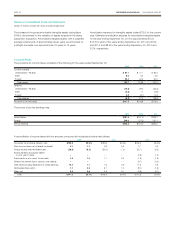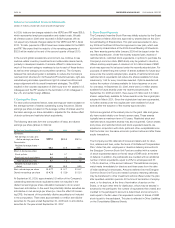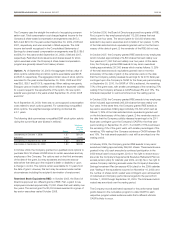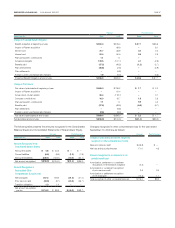Energizer 2009 Annual Report Download - page 32
Download and view the complete annual report
Please find page 32 of the 2009 Energizer annual report below. You can navigate through the pages in the report by either clicking on the pages listed below, or by using the keyword search tool below to find specific information within the annual report.
PAGE 30 ENERGIZER HOLDINGS INC. 2009 ANNUAL REPORT
Capitalized Software Costs Capitalized software costs are included
in Other Assets. These costs are amortized using the straight-line
method over periods of related benefit ranging from three to seven
years. Expenditures related to capitalized software are included in
the capital expenditures caption in the Consolidated Statements of
Cash Flows.
Property, Plant and Equipment, net Property, plant and equipment
is stated at historical costs. Property, plant and equipment acquired
as part of the shave preparation acquisition, in 2009, and the Playtex
acquisition, in 2008, was recorded at fair value on the date of acquisi-
tion. Fair value was established using a cost approach for the operating
fixed assets and comparable sales and property assessment data for
the valuation of land. Expenditures for new facilities and expenditures
that substantially increase the useful life of property, including inter-
est during construction, are capitalized and reported in the capital
expenditures caption in the Consolidated Statements of Cash Flows.
Maintenance, repairs and minor renewals are expensed as incurred.
When property is retired or otherwise disposed of, the related cost and
accumulated depreciation are removed from the accounts, and gains
or losses on the disposition are reflected in earnings. Depreciation is
generally provided on the straight-line basis by charges to costs or
expenses at rates based on estimated useful lives. Estimated useful
lives range from two to 25 years for machinery and equipment and
three to 30 years for buildings. Depreciation expense was $111.0,
$121.4 and $104.6 in 2009, 2008 and 2007, respectively.
Estimated useful lives are periodically reviewed and, when appropriate,
changes are made prospectively. When certain events or changes
in operating conditions occur, asset lives may be adjusted and an
impairment assessment may be performed on the recoverability of
the carrying amounts.
Goodwill and Other Intangible Assets Goodwill and indefinite-lived
intangibles are not amortized, but are evaluated annually for impair-
ment as part of the Company’s annual business planning cycle in
the fourth quarter. The fair value of each reporting unit is estimated
using valuation techniques such as discounted cash flows and Earn-
ings Before Interest, Taxes, Depreciation and Amortization (EBITDA)
multiples. Intangible assets with finite lives, and a remaining weighted
average life of approximately seven years, are amortized on a straight-
line basis over expected lives of 5 years to 15 years. Such intangibles
are also evaluated for impairment including on-going monitoring of
potential impairment indicators.
Impairment of Long-Lived Assets The Company reviews long-lived
assets, other than goodwill and other intangible assets for impairment,
when events or changes in business circumstances indicate that the
remaining useful life may warrant revision or that the carrying amount
of the long-lived asset may not be fully recoverable. The Company
performs undiscounted cash flow analyses to determine if impairment
exists. If impairment is determined to exist, any related impairment
loss is calculated based on fair value. Impairment losses on assets
to be disposed of, if any, are based on the estimated proceeds to be
received, less cost of disposal.
Revenue Recognition The Company’s revenue is from the sale of
its products. Revenue is recognized when title, ownership and risk of
loss pass to the customer. Discounts are offered to customers for early
payment and an estimate of such discounts is recorded as a reduction
of net sales in the same period as the sale. Our standard sales terms
are final and returns or exchanges are not permitted unless a special
exception is made; reserves are established and recorded in cases
where the right of return does exist for a particular sale. Under certain
circumstances, we authorize customers to return Sun Care products
that have not been sold by the end of the sun care season, which is
normal practice in the sun care industry. We record sun care sales at
the time the products are shipped and title transfers. Simultaneously
with the time of the shipment and title transfer, we reduce sun care
sales and cost of sales, and record an accrued liability on our Consoli-
dated Balance Sheet for anticipated returns based upon an estimated
return level. Customers are required to pay for the sun care product
purchased under the required terms. Due to the seasonal nature of sun
care, we offer a limited extension of terms to certain qualified custom-
ers. This limited extension requires substantial cash payments prior
to or during the sun care season. We generally receive returns of our
U.S. Sun Care products from September through January following
the summer sun care season.
The Company offers a variety of programs, primarily to its retail cus-
tomers, designed to promote sales of its products. Such programs
require periodic payments and allowances based on estimated results
of specific programs and are recorded as a reduction to net sales.
The Company accrues, at the time of sale, the estimated total pay-
ments and allowances associated with each transaction. Additionally,
the Company offers programs directly to consumers to promote the
sale of its products. Promotions which reduce the ultimate consumer
sale prices are recorded as a reduction of net sales at the time the
promotional offer is made, generally using estimated redemption
and participation levels. Taxes we collect on behalf of governmental
authorities, which are generally included in the price to the customer,
are also recorded as a reduction of net sales. The Company continu-
ally assesses the adequacy of accruals for customer and consumer
promotional program costs not yet paid. To the extent total program
payments differ from estimates, adjustments may be necessary.
Historically, these adjustments have not been material.
Advertising and Promotion Costs The Company advertises and
promotes its products through national and regional media and
expenses such activities in the year incurred.
Reclassifications Certain reclassifications have been made to the
prior year financial statements to conform to the current presentation.
Recently Issued Accounting Pronouncements Other than as
described below, no new accounting pronouncement issued or effec-
tive during the fiscal year has had or is expected to have a material
impact on the consolidated financial statements.
In December 2008, the Financial Accounting Standards Board (FASB)
issued new accounting guidance on Employers’ Disclosures about
Postretirement Benefit Plan Assets. This guidance is intended to pro-
vide users of financial statements with useful, transparent, and timely
information about the asset portfolios of postretirement benefit plans.
The amendments include the disclosure of fair value of categories
of plan assets, disclosure about the nature and amount of
Notes to Consolidated Financial Statements
(Dollars in millions, except per share and percentage data)


